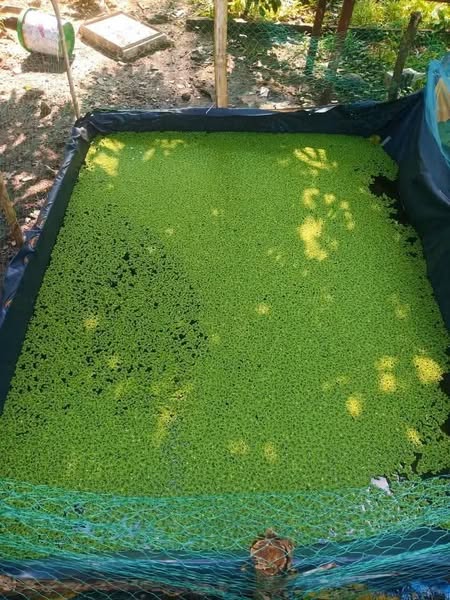Table of Contents:
- Introduction: What is Azolla Farming?
- Why Use a Dam Liner for Azolla Farming?
- Key Factors to Consider When Choosing a Dam Liner
- Types of Dam Liners for Azolla Farming 🔍
- HDPE Liners
- PVC Liners
- LLDPE Liners
- EPDM Liners
- Comparison Table: Best Dam Liners for Small-Scale Azolla Farming
- Case Study: Successful Azolla Farming with HDPE Liners
- Interactive Chat: Which Dam Liner is Right for You?
- FAQs on Azolla Farming and Dam Liners
- Tools & Resources for Azolla Farmers 🧰
- Conclusion and Call to Action
1. Introduction: What is Azolla Farming?
Azolla farming has gained popularity among small-scale farmers for its numerous benefits. Azolla, a floating aquatic fern, is a natural biofertilizer and a sustainable feed for livestock such as poultry, fish, and cattle. It thrives in shallow water, making it ideal for cost-effective farming.
To optimize Azolla production, creating the perfect environment is essential—and this is where dam liners come in. Dam liners ensure water retention, minimize contamination, and enhance productivity.
2. Why Use a Dam Liner for Azolla Farming?
Dam liners play a critical role in Azolla farming for the following reasons:
- Water Retention: Prevents water seepage and ensures consistent water levels.
- Contamination Prevention: Shields Azolla from soil impurities, debris, and harmful microorganisms.
- Cost Efficiency: Reduces the need for frequent water replenishment, saving money in the long run.
- Durability: Provides a stable and long-lasting base for repeated farming cycles.
Pro Tip: Investing in a high-quality dam liner can boost Azolla yields by up to 30%! 🌿
3. Key Factors to Consider When Choosing a Dam Liner
When selecting the best dam liner for small-scale Azolla farming, consider these factors:
- Material Durability: The liner must resist wear and tear, UV rays, and chemical damage.
- Thickness: A thickness of at least 0.5mm is ideal for long-lasting use.
- Flexibility: Especially important for irregularly shaped ponds.
- Cost: Balance quality and affordability to suit your budget.
- Environmental Impact: Opt for eco-friendly materials to protect aquatic ecosystems.
4. Types of Dam Liners for Azolla Farming 🔍
4.1 HDPE Liners
High-Density Polyethylene (HDPE) liners are the most popular choice for small-scale Azolla farming due to their durability and cost-effectiveness.
- Pros:
- UV-resistant.
- Chemically inert.
- Affordable for small-scale farmers.
- Cons:
- Limited flexibility.
4.2 PVC Liners
Polyvinyl Chloride (PVC) liners are flexible and easy to install, making them suitable for irregular pond shapes.
- Pros:
- Highly flexible.
- Suitable for small, custom-shaped ponds.
- Cons:
- Lower UV resistance.
- Shorter lifespan compared to HDPE.
4.3 LLDPE Liners
Linear Low-Density Polyethylene (LLDPE) liners offer a blend of flexibility and durability.
- Pros:
- Excellent puncture resistance.
- Environmentally friendly options available.
- Cons:
- Slightly more expensive than HDPE.
4.4 EPDM Liners
Ethylene Propylene Diene Monomer (EPDM) liners are known for their exceptional flexibility and longevity.
- Pros:
- Extreme durability.
- High resistance to weather changes.
- Cons:
- Higher upfront cost.
5. Comparison Table: Best Dam Liners for Small-Scale Azolla Farming
| Dam Liner Type | Durability | Flexibility | Cost (KES/m²) | UV Resistance | Best For |
|---|---|---|---|---|---|
| HDPE | High | Moderate | 250 | High | Cost-conscious farmers |
| PVC | Moderate | High | 350 | Moderate | Irregular ponds |
| LLDPE | High | High | 400 | High | Versatile needs |
| EPDM | Very High | Very High | 600 | Very High | Long-term projects |
6. Case Study: Successful Azolla Farming with HDPE Liners
Farmer Profile: Mary, a small-scale farmer from Nakuru, Kenya.
Problem: Frequent water seepage and poor Azolla yields.
Solution: Mary installed an HDPE dam liner in her 10×5-meter pond.
Results:
- Water retention improved by 95%.
- Azolla yield increased by 40% within six months.
- Reduced water consumption, saving her KES 5,000/month.
Mary’s success story highlights the transformative impact of high-quality dam liners on small-scale farming.
7. Interactive Chat: Which Dam Liner is Right for You?
Answer these questions to determine the ideal dam liner for your needs:
- What’s your budget?
- Low: HDPE
- Moderate: LLDPE or PVC
- High: EPDM
- Is your pond irregularly shaped?
- Yes: PVC or LLDPE
- No: HDPE
- How long do you need the liner to last?
- 5+ years: HDPE or LLDPE
- 10+ years: EPDM
8. FAQs on Azolla Farming and Dam Liners
Q1: How thick should a dam liner be for Azolla farming?
A: A thickness of 0.5mm to 1.0mm is recommended for durability and leak prevention.
Q2: Can I use regular plastic sheets instead of a dam liner?
A: No. Plastic sheets are prone to tears and UV damage, leading to higher maintenance costs.
Q3: How do I maintain my dam liner?
A: Regularly clean the liner and avoid sharp objects that could cause punctures.
9. Tools & Resources for Azolla Farmers 🧰
- Water Storage Cost Calculator: Estimate the cost of dam liners for your Azolla Pond.
- Azolla Farming Guide (PDF): Downloadable resource with tips and tricks.
- Pond Maintenance Checklist: A free template to ensure optimal performance.
10. Conclusion
Choosing the best dam liner for small-scale Azolla farming can significantly impact your yields and cost savings. Whether you’re just starting or looking to scale your operations, investing in a high-quality liner is the first step to success.
🙏 Ready to get started? Explore our selection of top-rated dam liners and enjoy free installation guidance. Click here to shop now!
Summary
“Looking to boost your Azolla farming yields? Discover the best dam liners for small-scale farmers in this comprehensive guide. Case studies, comparisons, and FAQs included! Click to learn more.”

